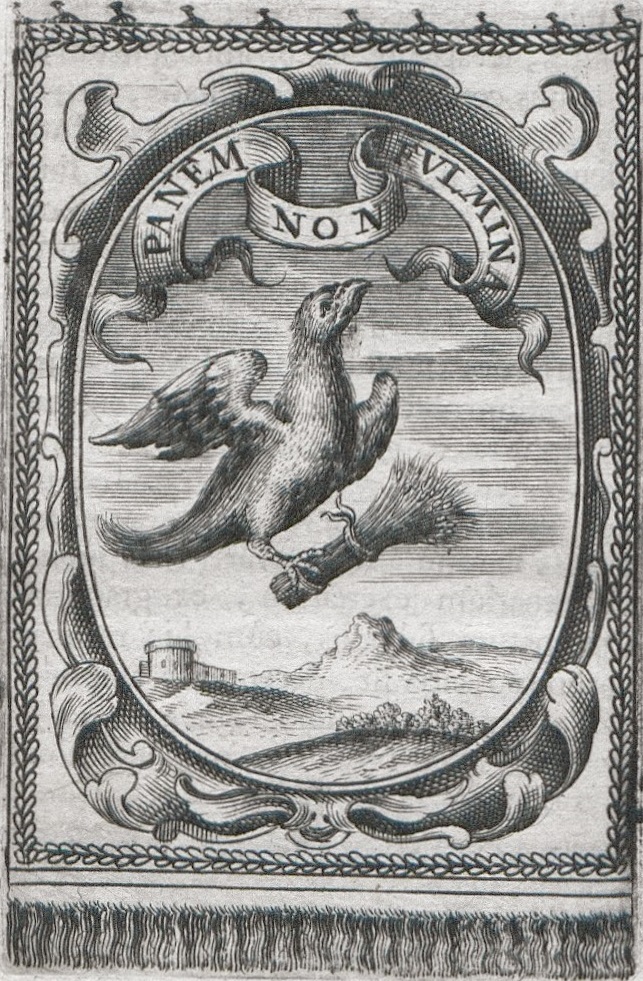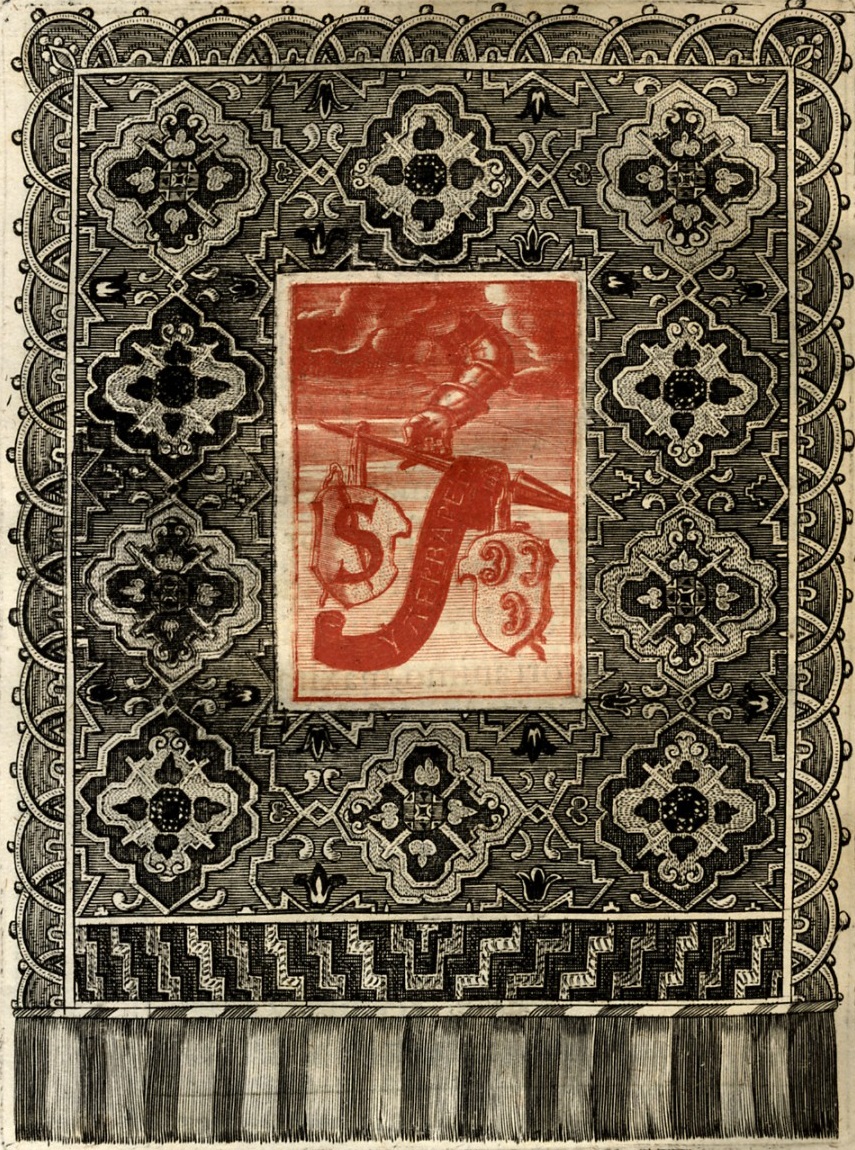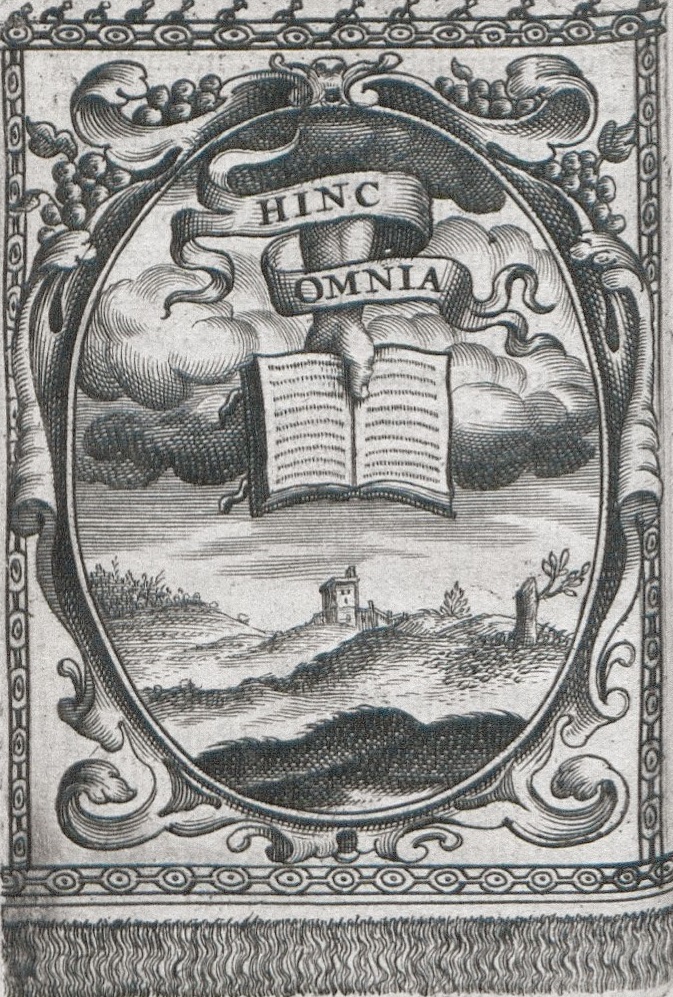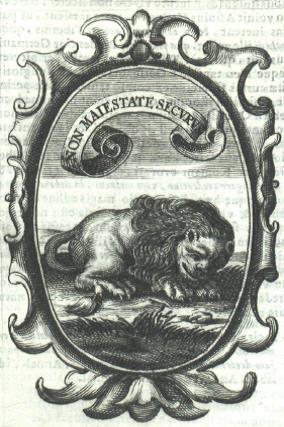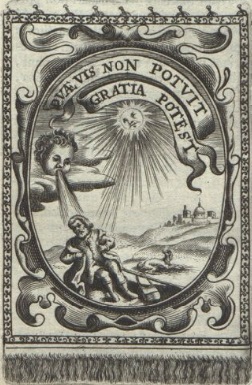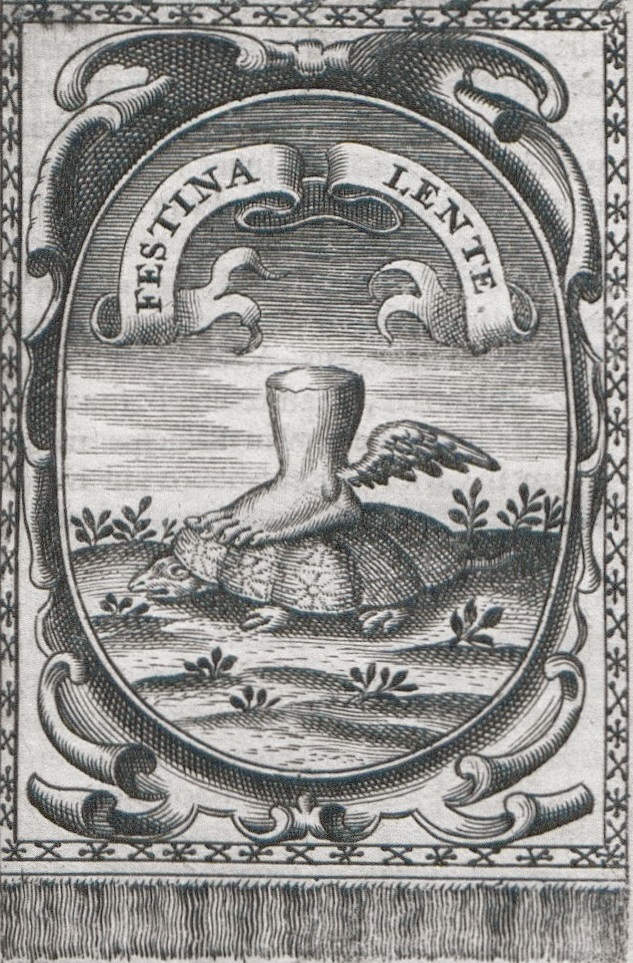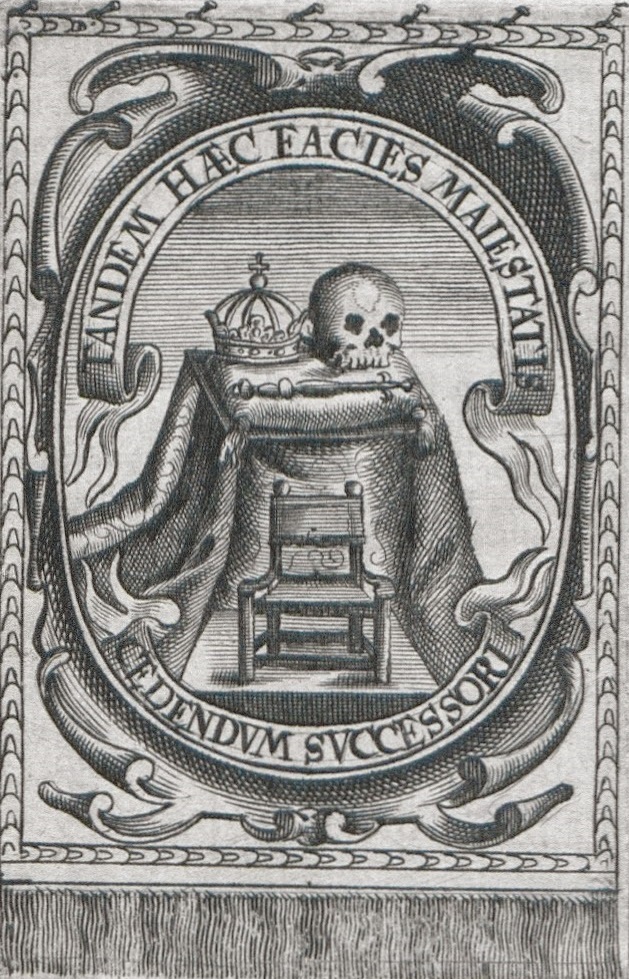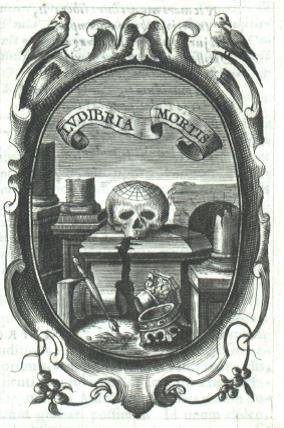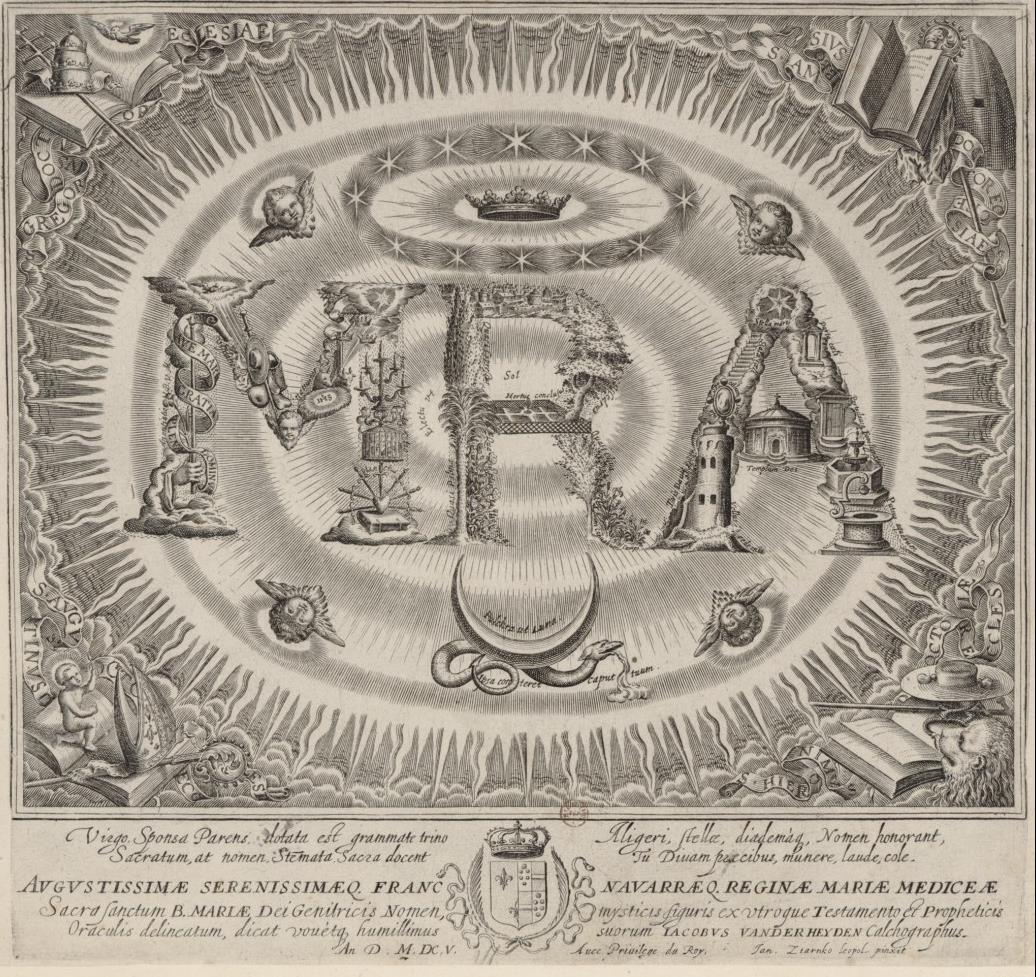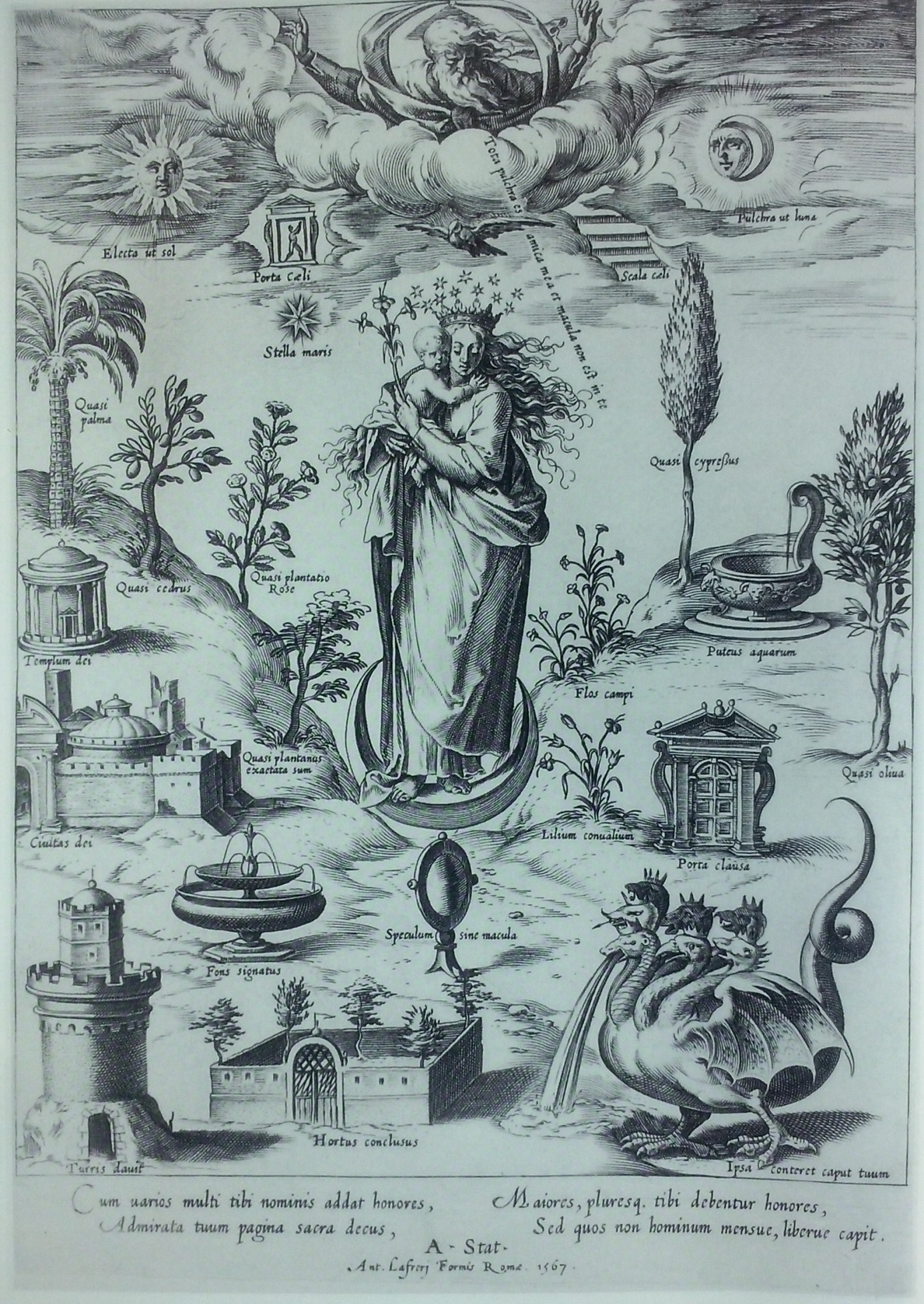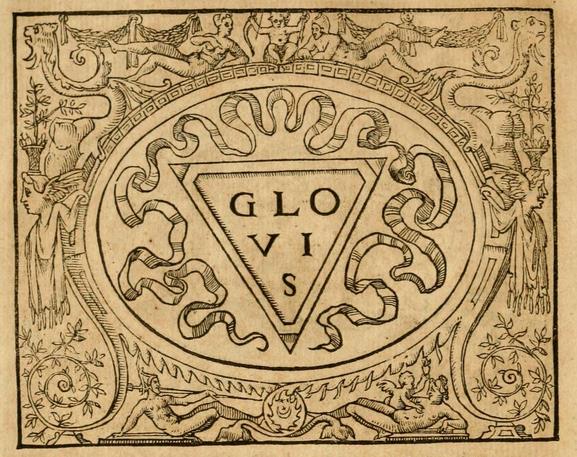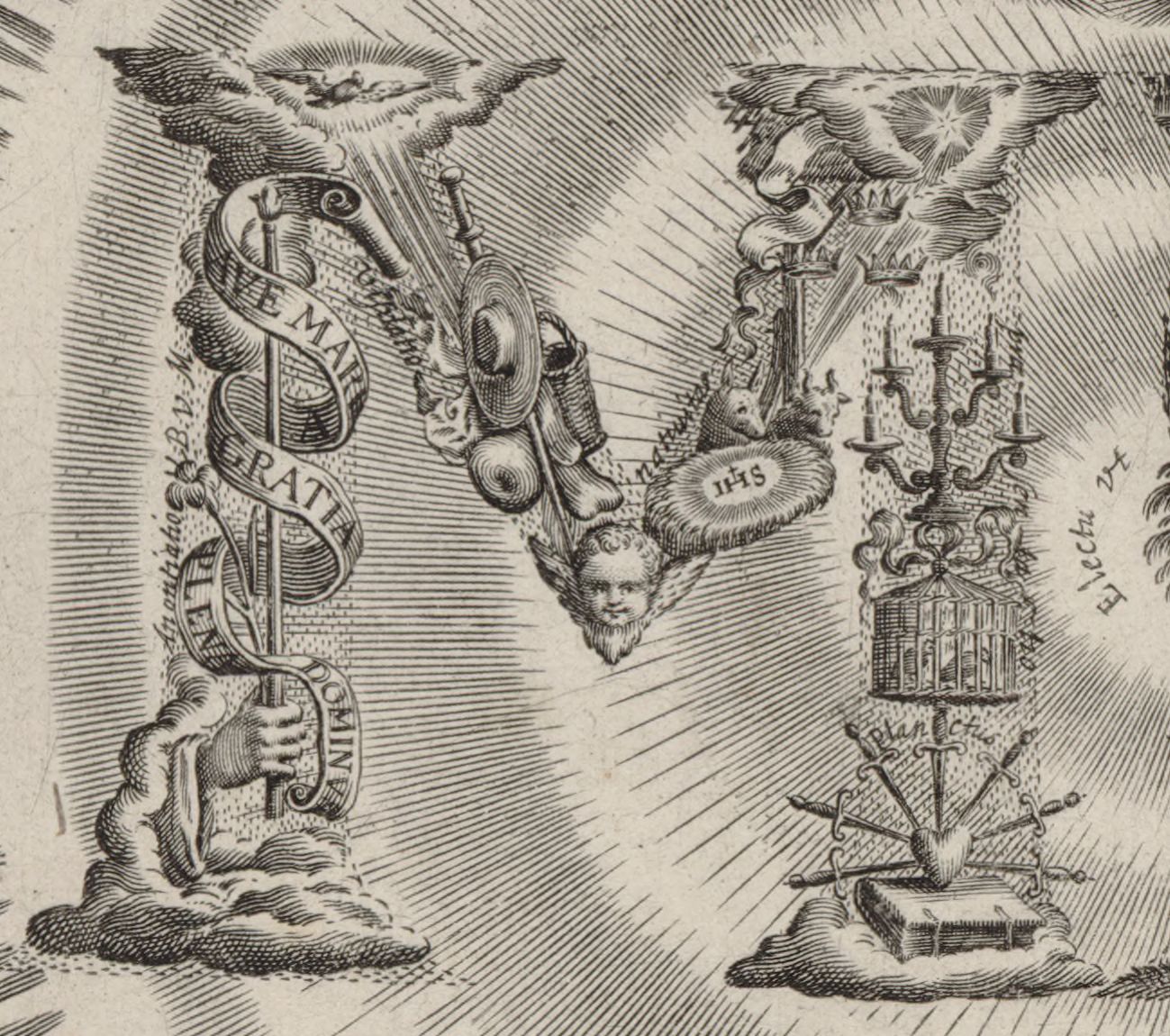News UK
ANNA KOŁOS
SOME REMARKS ON THE ICONOGRAPHY OF EMBLEMATIC EXHORTATIONS IN THE “PERISTROMATA REGUM” COLLECTION BY ANDRZEJ MAKSYMILIAN FREDRO
|
Published in 1660 in Jerzy Forster’s publishing house[1] in Gdańsk as part of the volume Scriptorum seu togae et belli notationum fragmenta, the collection of twenty copper prose engravings by Andrzej Maksymilian Fredro known as Peristromata regum, seu memorial principis monitorum symbolis expressum was rightly ranked by Janusz Pelc among the most interesting compositions of 17th-century Poland.[2] Despite this praise, the cycle has not yet been analysed in depth.[3] This article is an attempt to signal several issues of iconography and composition which deserve broader attention. The issue of nomenclature seems to be the most important: the title is closely related to the form of the cycle. In the paratext, Fredro used the rare Greek term peristroma,[4] which means a ‘carpet’, ‘tapestry’ or ‘bed covers’. In the preface, the writer, who is fluent in the art of compiling, describes his work as a supplement to the collection Scriptorum Fragmenta, thus making it a selection from his earlier works.[5] The main source upon which Fredro drew in the creation of the cycle seems to have been “non-literary” emblematics,[6] decorations in private and public space (royal apartments) which, while pleasing to the eye, are also morally didactic. Remaining in accord with the accustomed function of an emblem (delectare et docere), Fredro explains the singular form of Peristromata as a literary counterpart to the imagery that could potentially decorate the walls of a royal palace. In the emblematic tradition before Fredro there is one piece that is well known: a rather slim volume entitled Peristromata turcica, sive dissertation emblematica.[7] It is a Latin translation of an anonymous French print published in 1641 in Nuremberg. One year later a replica was published, Aulaea Romana.[8] In place of the Greek lexeme, it proposes the Latin word “aulaeum”. In addition to those on its title page, Peristromata Turcica contains six colourful emblems placed on an ornamental tapestry adorned with decorative tassels at the bottom. In the centre are several small fields consisting of allegorical scenes and Greek lemmas (ill. 2). Engravings from this edition, which was probably known all around the country, especially in Gdańsk,[9] can be described as the closest in terms of artistic form to the ones from Fredro’s collection.[10] Their author is unknown.[11] Just as in the case of the Nuremberg print, the Polish emblems are clearly intended to imitate the look of a decorative tapestry – in addition to the tassels they depict, in the top part of the engraving, the nail heads which would be used to hang the tapestry (ill. 3). The icon itself takes on the form of an allegorical image in a vertical oval framed by a cartouche with a scroll.[12] The cartouche, on the other hand, is written into a square framed like a decorative carpet. The composition in general is highly coherent. Each icon in the top part of the oval field consists of a decorative flag with a Latin lemma. Only the border changes. In comparison to German prints, the framing of Polish tapestries seems ascetic. The ornaments do not obscure the main allegory, which dominates the decorations by means of its size. An artistic analysis of the imago itself indicates resemblance to engravings from a collection of emblems which became famous in Poland: the Spanish Idea de un principe politico Cristiano by Diego de Saavedra Fajardo (ill. 4), published in 1640 in Munich.[13] Fredro greatly respects Saavedra and calls him “Nobilis scriptor Hispanus”.[14] Among multiple similarities between the two writers we could enumerate a moralising attitude, didacticism, an attempt to a pragmatic comments upon the power theories when traditional Christian-Ciceronian ethics experiences a crisis, closeness to Justus Lipsius political reflections, scepticism towards the psychology of both an individual and a group and finally, adding gravity to dissimulations.[15] In terms of writers’ practice, both authors adorned their speculorum principum emblems with commentaries in the form of essays. This method was compatible with the character of their works as a noble otium crafted in moments of peace between fulfilling their political duties.[16] Fredro’s iconography is highly diversified and unique. His didactic recommendations are generally theoretical, which makes it possible for him to get rid almost entirely of the catalogue of most popular and prolific personifications of virtues or static allegories of non-material values. It is interesting how much stress is put on setting the scenes against the background of natural sceneries; this is contrary to older related prints, such as Typotius’ Emblemata, which use an abstract background. The artist uses the fixed motif of manus Dei, a hand emerging from the clouds. This, just as in Saavedra’s piece, allows him to introduce allegorical forms (Peristroma I, II, III, VIII, and XIV). Another important aspect is the role of parabolic scenes with animal symbols (Peristroma VII and XII), which can be considered part of a common tendency to draw comparisons between politics and the animal world. It works especially in the context of artis dissimulandi. In the tapestries mentioned the author unambiguously characterises animal behaviours that should also be followed by rulers. Secrecy is a feature represented by an owl, hunting in the dead of night (secreto videt); silence (taciturnitas),[17] emotional continence and apparent apathy are pictured by a fox who “lies as if he were dead and easily catches birds”.[18] Saavedra uses similar measures. Writing of dissimulation, he calls upon the image of a serpent, and a lion who sleeps with his eyes open (vigilantia).[19] In Fredro’s work, the owl is distantly related to a picture from Pierio Valeriano’s Hieroglyphica (1556) – a night heron symbolises a tyrant. It is significant that Fredro, while advising a ruler to be deceitful, makes the image morally unambiguous, as it would not have been in the 16th century.[20] Also within the representation of natural world is the 15th emblem (vescitur paleis). It depicts a horse tied to a wooden pole and is closer to a genre scene than to an allegory. The same could be said about the 18th tapestry (Altum crescent caeterum steriles). The image depicts seven slender trees which only become an allegory for vain greatness without virtue when a commentary is added. Emblem number 4 is especially interesting, given the background of iconographic erudition of the cycle’s creators. Entitled Quae vis non potuit gratia potest (Ill. 5), it is in fact an illustration of Aesop’s fable about the North Wind and the Sun. The moral of the story blends very well with the notion of the strength and efficacy of a gift, expressed in the emblems Panem non fulmina (5) and Dando accipit (8). Among the rich exemplary materials gathered by Fredro in his moral writing, references to fables are quite rare. Sun and wind being animalised in the emblem’s icon[21] also stands out in the context of Peristromata. As was said in Krzysztof Niemirycz’s fable written at the end of the 17th century, “Quiet strength reaches the heart sooner than loud”.[22] Fredro, on the other hand, summarised this message in an aphorism: “Sic gratia profecit quantum vis non potuisset”,[23] advising the ruler to act similarly towards his subjects, treating them “more like sons than like slaves”.[24] Festina lente (Ill. 6) is the only emblem referring to the most important and prolific watchwords. In its icon we can see a winged foot standing on top of a turtle’s shell. This causes a visual contamination of various symbolic images. Next to identifying a gnome with Aldus’ printer’s signature, the turtle became one of the most common carriers of meaning. In Cosimo de Medici’s emblem we can see a spread sail on the turtle’s back.[25] It is similar to the image shown by Peter Isselburg and Georg Rem in their print Emblemata politica (Nuremberg, 1617).[26] The Hypnerotomachia on the other hand is the source of the image of a woman holding wings in one of her hands, and a turtle in the other.[27] The variation made by Fredro seems to connect to famous visual traditions, conceptualising the motif of wings together with a foot resembling classical depictions of Mercury. Peristroma 16 (Quae ad naturam non nocent), displaying a burning salamander, refers to concepts from Classical natural history,[28] which states that this reptile is capable of devouring fire, while ostriches eat iron.[29] A salamander in flames, together with a royal crown and a Nutrisco et extinguo lemma, became a watchword for Francisco I; the version without royal attributes was included in Typotius’ collection as an icon inscribed Durabo and Mi nutrisco.[30] For Fredro, the salamander became an embodiment of the thesis that harmony exists between nature and humanity, calling for respect for different habits on the socio-political plane. It also makes the notion of natural law, broadly discussed in the 17th century, part of the author’s conservative understanding of the authority of tradition, especially in connection with noble liberty. In the 19th emblem, entitled Nihil tam firmum est cui periculum non sit etiam ab invalido, Fredro uses a common hieroglyphic sign, an elephant, but with no reference to the repertoire of virtues[31] this animal used to symbolise. Instead he provides a description from the writings of a historian, Curtius Ruphus. The relation between the picture and lemma is based on contrast and depicts a thought crucial for Fredro – of power’s vanity and fragility – since “even elephants fear mice”.[32] Among other motifs depicted in Fredro’s cycle a special place should be granted to an independent architectural motif: caesura nisi cohaerentia, a stone-clad vault symbolising “consent between citizens”.[33] It is thus a group composition in which the people hold up the royal crown (his fulcris potens). Another separate element is Peristroma 6 (Non omnibus) which depicts a curtain drawn in an interior with precisely drawn architectural details (columns adorned with acanthus holding up a vault with an oculus), referring to Solomon’s temple.[34] In his commentary, the author expresses his certainty about the necessity of upholding the king’s majesty by his seclusion and indifference, again displaying his sociotechnical sense. Finally we should pay some attention to the emblem which concludes the volume, tandem haec facies maiestatis cedendum successori,[35] which refers to the futility of life (a skull next to royal attributes and an empty throne). In his moralising attempts Fredro does not reach for pedagogics of fear or appeal to life’s vanity. But in Peristroma 20 (ill. 7) he does use the attractive motif of death which concludes the topic of pondering on good Christian rulers, praising those who are remembered by their descendants. It is here that another similarity to Saavedro can be found: he terminated his cycle with an image of a grave with royal attributes (Futurum indicat).[36] His work ends with a reflection on the ruler’s place in his subjects’ memory. In an epilogue to the Spanish author’s cycle there is also an emblem signifying vanity: Ludibria mortis (ill. 8), adorned with a poetic subscription.[37] Fredro in his iconography uses motifs from the epilogue – but he adds a reflection which draws closer to Saavedro’s last essay, praising the good death and honoured memory of the ruler. Against the background of Fredro’s moral and political writings, Peristromata is an example of his closeness to Saavedro’s ideas. He was, however, also familiar with Lipsius’ works, a writer who believed that, contrary to Plato’s ideas, “we live among people who seem to be made of nothing but greed, deception and lies”.[38] Fredro does not present simplistic ideas of moral perfection that would be in accord with the contemporary ideas of rulers’ virtuousness. He believed firmly in people’s weakness (fragilitas humana), and did not even spare the king.[39] The pragmatic aspect of his reflections makes his work unique: he does not satisfy himself with standard conventions on either the intellectual or the visual tier. Instead Fredro strives to broaden the fields of meaning for the symbols he uses, in order to fulfil his ever-present didactic intention.
Translated by Zofia Marcinek
[1] A.M. Fredro, Peristromata regum, [in:] Scriptorum seu togae et belli notationum fragmenta; accesserunt Peristromata regum symbolis expressa, sumptibus Georgii Försteri, Dantisci 1660, p. 305–381. The subsequent edition, with a different graphic layout, was published in 1685 in Frankfurt. All quotations are after the modern critical edition: A.M. Fredro, Scriptorum seu togae et belli notationum fragmenta. Accesserunt “Peristromata regum symbolis expressa”. Fragmenty pism, czyli uwagi o wojnie i pokoju. Zawierają dodatkowo „Królewskie kobierce symbolicznie odtworzone”, tr. J. Chmielewska, B. Bednarek, foreword M. Tracz-Tryniecki, Narodowe Centrum Kultury, Warszawa 2015 [2] J. Pelc, Słowo i obraz na pograniczu literatury i sztuk plastycznych, Universitas, Kraków 2002, p. 252. [3] For the most important editions, see p. 252–259; Z. Rynduch, Andrzej Maksymilian Fredro (portret literacki), Gdańskie Towarzystwo Naukowe, Gdańsk 1980, p. 111–121; U. Olbromska, Kobierce, czyli ilustracje do „Peristromata regum symbolis expressa” A. M. Fredry, “Galicja” 2000, vol 1, p. 37–43. [4] In the representative function of a particular designate, the word was used by Roman authors such as Plautus or Cicero. As a literary term it appears in the 17th century, for the first time in the title of the Peristromata sanctorum collecta collection of Arnold de Raisse (1630). [5] See A. M. Fredro, Peristromata regum, [in:] Scriptorum fragmenta, p. 655. [6] This is especially the case in the description of Panem non fulmina (5), depicting an eagle with a bundle of grain in his talons (the blazonry of the Waza family), bringing bread instead of thunder – this image was originally supposed to adorn the chamber of Władysław IV. The author treats this as an exemplum in his preface and then develops it in Peristroma 5 (ill. 1). In the tenth emblem (his fulcris potens) he refers to the famous “Wawel heads” adorning the ceiling of the Parliament chamber. [7] Peristromata Turcica, sive dissertatio emblematica, praesentem Europae statum ingeniosis coloribus repraesentans, [Wolfgang Endter, Nürnberg 1641]. On the title page there is no indication of where and in which house the piece was published; the date is encrypted within a chronogram. The colophon contains information on the French edition: “Lutetiae Parisiorum primum apud Toussaint du Bray, in platea P. Jacobi ad insigne Spicae”. [8] [G.P. Harsdörffer], Aulaea romana contra Peristromata turcica expansa, sive dissertatio emblematica concordiae christianae omen repraesentans, [Wolfgang Endter, Nürnberg 1642]. [9] See J. Pelc, op. cit., p. 255 [10] In the Aulaea romana pamphlet the artistic idea for the emblems was changed: the authors eliminated the elements directly resembling carpets or tapestries; the only possible remaining example is Peristromata turcica. [11] The suggestion has been made that differences in spelling point towards there being more than one author (U. Olbromska, op. cit., p. 43). [12] The first emblem has motifs of fruits written into the retracting cartouche element. [13] Saavedro’s authority was called upon by Fredro (Scriptorum fragmenta, Monita) and Stanisław Herakliusz Lubomirski (Rozmowy Artaksesa i Ewandra). In the Cistercian abbey in Sulejów, probably before 1686, someone created a decoration for the church organs which used four emblems of the Spanish artist (see P. Rosiński, Obrazy emblematyczne w kościele Cystersów w Sulejowie, “Kieleckie Studia Teologiczne” 2002, vol 1–2, p. 413–425). Similarities have been noted by Paulina Buchwald-Pelcowa (Emblematy w drukach polskich i Polski dotyczących XVI–XVIII wieku. Bibliografia, IBL PAN, Ossolineum, Wrocław, Warszawa 1981, p. 39). Saavedro’s works were reissued many times in Spanish, and between 1649 and 1659 were also issued in Latin in Brussels, Köln and Amsterdam. It is possible that Fredro used one of these. The closest probable model for Saavedro is Emblemata politica by Jacob Bruck Angermundt, published in Köln and Strasbourg in 1618. See F. J. Díez de Revenga, Introducción, [in:] D. de Saavedra Fajardo, Empresas políticas, edición, introducción y notas de F.J. Díez de Revenga, Planeta, Barcelona 1998, p. XL; R. Bireley, The Counter-Reformation Prince. Anti-Machiavellianism or Catholic Statecraft in Early Modern Europe, The University of North Carolina Press, Chapel Hill 1990, p. 194. [14] A. M. Fredro, op. cit., p. 640. [15] See M. Tracz-Tryniecki, Wstęp, [in:] A.M. Fredro, Scriptorum fragmenta, p. 52–53. [16] Both authors mention this issue: A. M. Fredro, Librorum legendorum ratio, [in:] Scriptorum fragmenta, p. 647; D. de Saavedra Fajardo, op. cit., p. 7–8. [17] Taciturnitas is for Fredro, just as it is for Saavedro, an important issue to reflect upon. He returns to it in his Monito as well. In the 12th emblem (Non auceps nisi dormiat) Fredro says “Taciturnitas etiam est pars dissimulatonis, imo ipsa Mater” (A. M. Fredro, op. cit., p. 730). Saavedro on the other hand claims silence is the ruler’s most important tool (D. de Saavedra Fajardo, op. cit., p. 278). [18] A. M. Fredro, op. cit., p. 731. [19] The issue of dissimulation is best described by Saavedro in emblems 43 (Ut sciat regnare), 44 (Nec a quo nec ad quem), and 45 (Non maiestate securus). See D. de Saavedra Fajardo, op. cit., p. 274–289. [20] As Valeriano wrote, “Huius quodammodo generis est Nycticorax, qui tyrannidem significat, ob occultationem scilicet consiliorum, quae dissimulare potentiores pro magno habent negotio” (P. Valeriano, Hieroglyphica, sive de sacris Aegyptiorum literis commentarii, [Michael Isengrin], Basileae 1556, p. 148: XX, Tyrannus). The author mentions a night heron, but the subsection is in the section entitled De noctua, and is accompanied by a drawing which definitely depicts an owl. [21] This is similar to illustrations of fables such as Cento favole morali by Giovanni Mario Vendizotti, reissued many times since 1570. [22] K. Niemirycz, Wiatr i Słońce, [in:] Antologia bajki polskiej, selected and edited by W. Woźnowski, Ossolineum, Wrocław 1982, p. 170 (v. 39–40). [23] A. M. Fredro, op. cit., p. 676. [24] Ibidem, p. 677. [25] H. B. Werness, The Continuum Encyclopedia of Animal Symbolism in World Art, Continuum, New York, London 2006, p. 416. [26] See M. Praz, Studies in Seventeenth-Century Imagery, Edizioni di Storia e Letteratura, Roma 1964, p. 381. [27] See J. Pelc, op. cit., p. 258. [28] The main point of reference is Pliny’s Natural History. See “Salamandra sive alitur igne, sive extinguit ignem, ut Plinius tradit…” (J. Typotius, Symbola divina et humana pontificum, imperatorum, regum. Accessit brevis et facilis isagoge. Tomus primus, Pragae 1601, p. 66: Hierographia regum christianorum, XXI). [29] A. M. Fredro, op. cit., p. 755. [30] J. Typotius, op. cit., p. 37 (Regum francorum…, XXIV), p. 66 (Hierographia regum christianorum, XXI). [31] In Valeriano’s works the elephant is a symbol of (among other things): goodness (pietas), justice (aequitas), munificence (munificentia), and moderation (temperantia). See P. Valeriano, op. cit., p. 14–20. [32] A. M. Fredro, op. cit., p. 781. [33] Ibidem, p. 737. [34] Ibidem, p. 689. [35] We may also notice a slight departure from the customary convention of placing bands with Latin lemmas in the top part of the depiction. Peristroma 20 is the only one in the collection to feature a band surrounding the entire icon. [36]A. M. Fredro, op. cit., p. 781. [37] Ibidem, p. 683. [38] J. Lipsius, Politica Pańskie, to jest, Nauka jako pan i każdy przełożony rządnie żyć i sprawować się ma, nie tylko panom pożyteczna, ale i nie panom ucieszna…, ed. Paweł Szczerbic, w Drukarni Łazarzowey, Kraków 1595, p. 123. [39] A. M. Fredro, Peristromata regum, p. 691. |
Ill. 1. Peristroma V (Regnum Poloniae) [in:] Peristromata turcica, sive dissertatio emblematica, praesentem Europae statum ingeniosis coloribus repraesentans, [Wolfgang Endter, Nürnberg 1641], p. D3v.
Ill. 3. D. de Saavedra Fajardo, Symbolum XLV (Non maiestate secures), [in:] idem, Idea principis christiano-politici, 101 siimbolis espressa, apud Iacobum van Meurs, Amstelodami 1651, p. 340.
Ill. 4. D. de Saavedra Fajardo, Symbolum XLV (Non maiestate secures), [in:] Idea principis christiano-politici, 101 sijmbolis espressa, Apud Iacobum van Meurs, Amstelodami 1651, p. 340.
Ill. 6. A. M. Fredro, Peristroma XVII (Festina lente), [in:] idem, Scriptorum fragmenta…, p. 370.
Ill. 8. D. de Saavedra Fajardo, Ludibria mortis, [in:] idem, Idea principis christiano-politici…, p. 831.
|
MAŁGORZATA BIŁOZÓR-SALWA
THE MONOGRAM OF THE VIRGIN MARY (1605) BY JAN ZIARNKO AS MARIA DE MEDICI’S DEVICE[1]
|
When Janusz Pelc was describing the struggles of 17th-century artists trying to picture the world and the knowledge about it in a catalogue of symbols, he noted the changes which took place in 17th-century emblematics and its “younger sibling” iconology.[2] The evolution of these arts is perfectly exemplified in the changes and modifications undergone by Cesare Ripa’s Iconology.[3] In 1636, less than hundred years after Ripa’s initial publication, a French writer by the name of Jean Baudoin published in Paris an extended translation of Ripa’s text, entitled Iconologie ou Explication nouvelle de plusieurs images, emblèmes, et autres figures hyerogliphiques […] Recherches et Figures de Cesar Ripa […] moralisées par I[ean] Baudoin.[4] Pelc stressed the fact that Baudoin in his edition not only added different variations of the notions which were in use, but also underlined their internal diversification. He showed the concomitance of contradictory notions and their build up in a baroque opposition of concors discordia.[5] Thanks to that, the French version of Iconologie was perfect in its depiction of the spirit of the time and place in which it was created. Understanding the spirit of the times seems crucial in research on various emblematic structures – as Daniel S. Russell, one of the most important scholars of emblematic structures and author of the fundamental The Emblem and Device in France, has said, the intellectual, cultural and literary life of the time was permeated by emblematic thought.[6] One should remember that, although theoretical texts codified emblems and were a source of inspiration for future creators, they were first and foremost indices of works already created. According to Pelc, in order for Iconologie to be written, France must have undergone a very specific development of thought, shaped by artists and their work. Among the artists responsible for this development, Pelc distinguished two Polish-born engravers: Jeremiasz Falck, an artist from Gdańsk, and Jan Ziarnko from Lwów.[7] Jan Ziarnko (active from 1598 to 1629), a painter and engraver, was trained in his hometown of Lwów and in Cracow. As an experienced artist, in 1598 he left Poland for an artistic journey to Italy. Finally, after 1605, he settled in Paris.[8] All his works which are currently known are related to France and Paris. In previous research, only two of his works have caught the attention of researchers focusing on iconology and emblems. One of them, Emblem – satire on the life and death of Concino Concini (Tableau et Emblemes de la detestable vie et malheureuse fin du Maistre Coyon) from 1617, was analysed for the first time by Stanisława Sawicka, an author of monographs on Ziarnko’s works.[9] Emblem, which exists in two versions prepared by the author, is a satirical and witty depiction of Maria de Medici’s favourite. The work, an emblematic broadsheet of the type popular in France at the beginning of the 17th century, employed a special kind of volatile prints.[10] The second piece was acknowledged by Jean Michel Massing in his research on the iconography of Lucanian ekphrasis. It is an etched title page of Les Œuvres de Lucian, published in 1613.[11] Massing focused on the composition of just one of the eight quarters which were used for the etching, noting at the same time that each of them could be treated as a separate emblem. The latest research on Ziarnko’s graphic œuvre proves that the concept of an emblem is foundational in many of his works. The earliest of these is the Monogram of the Virgin Mary from 1605[12] (ill. 1). This engraving was made by the Dutch publisher and engraver Jacob van der Heyden, based on Jan Ziarnko’s design. An elaborate composition, it consists of two elements: a picture and an inscription below. The text has a crucial function in understanding the whole composition. The picture is a monogram of the Virgin Mary in radiant glory, along with the attributes of the Fathers of the Church placed in the corners. Each letter of the monogram is an arrangement of Marian symbols, including the crown visible above and the crescent moon with a serpent visible below. Thus it does not matter if we assume the letters “MRA” to be an acronym of “MARIA” or rather initials for “Maria Regina Angelorum”; in either case their meaning remains unchanged, since it refers clearly to depictions of the Virgin. At the same time they are also part of a broad repertoire of Marian symbols visible on the engraving, since the canon of symbols worked out for medieval poetry was also used in visual arts.[13] Starting in the 15th century, depictions such as Maria Immaculata were connected to symbols correlated with the Loreto Litany, which in turn takes its symbols from the Song of Songs.[14] Examples of such works can be found all across Europe, since the motifs and iconographic patterns were quickly taken up by new centres, mostly due to rapid circulation of prints.[15] The Monogram of the Virgin Mary is a unique piece, compared to various European examples. Still, there are many analogies to different depictions. The closest are the images of the Virgin Mary surrounded by Marian Symbols, especially three engravings by Hieronimus Wierix.[16] Another example worth mentioning is the etching by Cornelis Cort, published in Rome by Antonio Lafreri in 1567 (ill. 2).[17] This is perhaps the most interesting one, since it depicts the Madonna with the Baby Jesus, standing on a crescent moon, surrounded by several Marian symbols. These symbols, similarly to Ziarnko’s work, are accompanied by inscriptions describing their meaning (among others Hortus conclusus, Quasi pala. Quasi cedrus, Speculum sine macula etc.). But in both prints the motifs are presented in an entirely different composition. Ziarnko substituted the image of the Virgin Mary with an inscription of her name. Furthermore, Mary’s name was not spelled out but presented in the form of a monogram, and the monogram itself was not calligraphed, but composed of symbols of various meanings. The strategy described above – building an image by means of concealed signs and symbols – brings to light an elaborate concept present in Ziarnko’s work. He seems to invite his readers to a game during which they are gradually to reveal new meanings.[18] The attitude of the artist, who not only manifests his knowledge but also expects the same erudition from the receiver of his work, somehow confirms Russell’s thesis – that 17th-century readers must be perceived as much in the emblematic context as the creators, at least because priests, preachers, Jesuit scholars and monarchs used emblems as a tool for education, politics or religion.[19] Emblematics and iconology were treated as knowledge indispensable to an educated man. It is not surprising, then, that on Ziarnko’s engraving, among conventional Marian symbols, we encounter motifs taken from contemporary emblematic literature. Claude Paradine’s Devises heroiques was first published in 1551 and then reissued several times. It is one of the earliest French publications devoted to watchwords.[20] The emblems contained in this publication, such as Nullis praesentior aether or Non sine causa, in which hands emerging from clouds (Dextra Dei) symbolise God’s direct involvement, find their analogy in the symbol of Annunciation in Ziarnko’s piece. A hand holding a lily and a pennant with the words of Angelic Greeting is the first symbol creating the letter “M”. But Paradin’s treatise is important not only due to the plenitude of motifs, but also because of the form of the watchword. Russell pointed out that, even though Paradin attempted to explain and define the idea of a watchword, he was not sufficiently interested in its form and the rules for its creation.[21] He also stressed that more important for further development and codification of such depictions in France was Paolo Giovio’s Dialogo delle imprese, published in 1555.[22] In a clear study, Giovio states five conditions a watchword (or an impresa) should keep. Firstly there should be balance between its two parts, the “spirit” and the “body” (the text and image, respectively). Secondly, the watchword must not be too obvious, but also not too complex. Thirdly, it should have a pleasing appearance. Fourthly – if possible – it should not contain images of human forms. The fifth condition was to make the motto as short as possible.[23] Ziarnko, by placing the monogram in a horizontal oval shape, is visibly alluding to illustrations from Giovio’s treatise. Furthermore, he follows his directives quite closely: the fourth recommendation is kept with the exchange of Mary’s face with the monogram “MRA”. It is also analogous, in a way, to the watchword of Julian de Medici, contained in the Lyon edition of Giovio’s work. In that version the image focuses on the depiction of the word and plays with its hidden meanings (ill. 3). This is seen in the word “GLOVIS” – backwards it reads “SI VLOG”, which means “it turns over”.[24] Additionally, the reader has to decipher the hidden meaning of the motto, divided into three lines: “GLO/VI/S”. It is a reference to changing fortune. All the mottos contained in the Lyon version refer to famous European personas. In almost all of the mottos for French rulers, there is a crown similar to the one used by Ziarnko. Sawicka, upon analysing the engraving, called it a “double homage to two Marias”: the Virgin Mary and Maria de Medici.[25] She also pointed out that there are two crowns depicted – one worn by French monarchs and the other – the crown of Mary – consisting of twelve stars. The connection between the two Marias becomes fully justified thanks to the inscriptions. Underneath the composition, still on the engraving, there is a four-verse invocation to the Virgin Mary and a six-verse invocation to Maria de Medici. According to the second one, the engraving was a gift for the “Queen of France and Navarra” (“Augustissimae Serenissimae Franc[iæ et] Navarræ Regine”). Although Maria de Medici was a queen by title, her actual coronation took place on 13th May 1610, one day before Henry IV’s tragic death. When the engraving was made, she was merely the king’s wife and mother of the future ruler. In Ziarnko’s composition the Virgin Mary’s maternity is accentuated by the fact that the first letter of the monogram refers to her being the Mother of God. Aside from the aforementioned symbol of the Annunciation, we can also find attributes of a pilgrim – a hat, cane and water bottle – referring to the Visitation of Saint Elizabeth (visitatio). An ox and an ass standing by the manger with Christ’s monogram refer to the Nativity and are connected to symbols of the Epiphany of the Three Kings – a star and three crowns. Mary’s suffering (planctus) is symbolised by a heart pierced by seven swords, and the Presentation at the Temple (præsentatio) is symbolised by a chandelier and a cage with doves (ill. 4). The role of a mother is also stressed in the incipit of the invocation – Virgo, Sponsa Parens. If analysed in this way, the watchword is a reference to the actual status of the king’s wife. Another analogy that should be mentioned is Catherine de Medici’s gesture. After Henry II died, she immediately took up an emblem stressing her status as a widow: Ardorem extincta testantur vivere flamma.[26] From that time, her widow’s watchword was placed on covers of books, prints and tapestries.[27] Russell, upon mentioning this symbolic gesture, pointed to the royal court as a place vital to the development of emblematic thought. Henry IV himself was known for his devotion to symbolic thinking and subtle plays of meaning in words and images. This was a mode of thinking present in the court in general. One expression of this is the creation of watchwords for the royal family by the royal minister, Maximilien de Béthune de Sully; another is the tradition of releasing gold and silver coins, New Year’s tokens, every year from 1603.[28] Maria de Medici was also strongly attached to the emblematic tradition. In 1601, when the future king Louis XIII was born, Louis Richeome dedicated to her his emblematic volume Tableaux Sacrez des Figures Mystique.[29] The book focused on the defence of Holy Communion.[30] In the collections of Walters Art Gallery there is also an anonymous, hand-written book containing 14 painted watchwords for Maria.[31] They glorify her characteristics, using solar motifs corresponding to divine harmony.[32] In Ziarnko’s composition there is also a solar reference – the monogram in radiant glory is inscribed with the words “beaming like the sun” (electa ut sol).[33] The writing in the middle of the engraving sets the ideological basis for the entire depiction and refers to the oldest Marian dogma, which tells of the “Divine Maternity of the Virgin Mary”.[34] The engraving which contains the monogram used as Maria de Medici’s watchword was made in 1605. It was at this time that Maria’s distant cousin Allessandro Ottaviano Medici was elected pope[35] under the name of Leo I, and this may have prompted the creation of the Monogram of the Virgin Mary, which would stress Maria de Medici’s high rank as both the king’s mother and a Catholic queen. Among the inscriptions underneath the composition there is also a signature pointing directly to Ziarnko as the author of the composition (“Joan. Ziarnko Leopol, Pinxit”). Accentuating the certain authorship of Ziarnko is important since there is a faithful copy of the Monogram, signed by the publisher and print seller Balthasar Caymox.[36] That engraving, although it copies faithfully both the image and invocation,[37] does not have a dedication to Maria de Medici. Thus, it loses its original meaning and Ziarnko’s witty concept in which the Marian monogram becomes a watchword for the Catholic Queen.
Translated by Zofia Marcinek
[1] The text contains findings formulated for a PhD thesis entitled The works of Jan Ziarnko and the background of the Parisian society of engravers and publishers in the first quarter of the 17th century. [2] J. Pelc, Słowo i obraz na pograniczu literatury i sztuk plastycznych, Universitas 2002, p. 355–357. [3] C. Ripa, Iconologia overo descrittione dell’imagini universali, Heredi di Gigliotti, Roma 1593. [4] J. Baudoin, Iconologie, Chez l’Auteur [J. Baudoin], Paris 1636. [5] J. Pelc, op. cit., p. 356–357. [6] D. S. Russell, The Emblem and Device in France, French Forum, Lexington 1985, p. 14. [7] J. Pelc, Obraz–słowo–znak. Studium o emblematach i literaturze staropolskiej, Zakład Narodowy im. Ossolińskich, Wrocław 1973, p. 260, op cit., p. 360. [8] On Ziarnko’s works see S. Sawicka, Jan Ziarnko peintre–graveur polonais et son activité a Paris au premier quart du XVIIe siècle, “La France et la Pologne dans leurs relation artistiques” 1938, nr 2–3; M. Biłozór–Salwa, Jana Ziarnki emigracja artystyczna, [in:] Francusko–polskie relacje artystyczne w epoce nowożytnej, ed. A. Pieńkos, A. Rosales Rodriguez, Neriton, Warsaw 2010, p. 23–32; J. Talbierska, Grafika XVII wieku w Polsce. Funkcje, ośrodki, artyści, dzieła, Neriton, Warsaw 2011, p. 45–49. [9] S. Sawicka, op. cit., p. 125–126, 166–166, nr 15, 16; see also Miłośnicy grafiki i ich kolekcje w zbiorach Muzeum Narodowego w Warszawie, ed. A. Grohala, Muzeum Narodowe w Warszawie, Warsaw 2006, p. 208, nr VI. 4. [10] Russell describes a number of French broadsheets (placcards), focusing on those devoted to royal marriages. In his writings he does not include Ziarnko’s works. D. S. Russell, Emblematic Structures in Renaissance France, University of Toronto Press, Toronto 1995, p.150–157; Wives and Widows: The Emblematics of Marriage and Mourning in France at the End of the Renaissance (1560–1630), [in:] Visual Words and Verbal Pictures, ed. A. Saunders, P. Davidson, Glasgow Emblem Studies, Glasgow 2005, p. 142–160. [11] J. M. Massing, The Illustrations of Lucian’s Imago vitae auliace, “Journal of the Warburg and Courtauld Institutes”, 1987, L, p. 214–219, reprinted in: J. M. Massing, Studies in Imagery: Texts and Images, vol. I, London 2004, p. 54–68. [12] S. Sawicka, op. cit., p. 177, nr 38. Juliusz A. Chrościcki postulated a careful analysis of the engraving during the conference French – Polish artistic relations in modern history (19.03.2009), which accompanied the exhibition Le Siecle Francais: French painting and drawing from Polish collections in the Warsaw National Museum. [13] B. Jollès, La formulation de la virginité de Marie dans la poésie latine médiévale, [in:] La virginité de Marie, Médiaspaul, Paris 1998, p. 137–156. [14] K. Moison-Jabłońska, Obrazowanie walki dobra ze złem, Universitas, Cracow 2002, p. 67. [15] See also Rola grafiki w procesie badania treści dzieł sztuki malarskiej czasów nowożytnych, [in:] Polskie przygody grafiki zachodnioeuropejskiej XVII–XVIII w., Sarmatia Artistica Maciej Kamil Jabłoński, Ciche 2013, p. 139–159. [16] K. Moison Jabłońska describes this motif as Mary Victorious; see Obrazowanie walki… op. cit., p. 67–70; the engravings described are H. Wierix after J. van der Straert, Virgin Mary surrounded by Marian symbols, engraving published by P. Galla; H. Wierix, Virgin Mary surrounded by Marian symbols, engraving; H. Wierix after M. de Vosa, Virgin Mary surrounded by Marian symbols, engraving published by J. B. Vrients. M. Mauquoy-Hendrickx, Les estampes des Wierix, vol. I, Bibliotheque Royale Albert I, Bruxelles 1978, p. 127–128, nr 707–708. [17] C. Cort, Virgin Mary surrounded by Marian symbols, 1567, etching published by A. Lafrery in Rome. M. Sellink, The New Hollstein. Cornelis Cort, ed. H. Leeflang Sound & Vision, Rotterdam 2000, p. 76–77, nr 93. [18] Many other interesting works by this artist, who was interested in hermeneutics, are based on the concept of searching for hidden meanings. The pursuit not only requires the reader to take part in an intellectual game, but also to show his erudition in order to fulfil the task. See M. Biłozór-Salwa, Anamorphosis as a Tool for Presenting Erotic Subjects: Some Remarks on Jan Ziarnko’s “Lovers”, [in:] “The Most Noble of the Senses”. Anamorphosis, Trompe-L’Oeil, and Other Optical Illusions in Early Modern Art, ed. L.H. Zirpolo, Zephyrus Scholarly Publications LLC, Ramsey 2016, p. 31–48. [19] D. S. Russell, 1985, The Emblem…, op. cit., p. 14. [20] C. Paradin, Devises Heroiques, Ian de Tournes et Guil Gazeau, Lion 1551. [21] D. S. Russell, The Emblem… op. cit., p. 38. [22] P. Giovio, Dialogo delle imprese, Antonio Barre, Roma 1555; see D. S. Russell, The Emblem… op. cit., p. 38; In 1559 Lodovico Domenichi prepared another edition of the text adorned with illustrations, which contributed to the popularity of the Italian treatise; see http://www.italianemblemp.artp.gla.ac.uk/bookinfo.php?bookid=sm_0520 [available 12.09.2016]. [23] Op. cit., p. 39; Pelc 2002, p. 36. [24] Giovio 1562, p. 72; cf. T. C. Price Zimmerman, Paolo Giovio and the Crisis of the Sixteenth-Century Italy, Princeton University Press, Princeton 1995, p. 22–223. [25] Sawicka 1938, p. 177, nr 38. [26] D. S. Russell, Wives and Widows… op. cit., p. 142. [27] I. de Conihout, P. Ract-Madoux, Veuves pénitents et tombeaux. Reliures français du XVIe siècle à motifs funèbres de Catherine de Médicis à Henri III [in:] Les Funétailles à la Renaissance, ed. J. Balsamo, Droz, Genève 2002, p. 225–231. [28] D. S. Russell, The Emblem… op. cit., p. 40–43; cf. Wives and Widows… op. cit., p. 144. [29] L. Richeome, Tableaux sacrez des figures mystiques, Laurent Sonnius, Paris 1601. [30] A. E. Spica, L’emblématique catholique de dévotion en France au XVIIe siècle: Quelques propositions de lecture [in:] An Interregnum of the Sign. The Emblematic Age in France, ed. D. Graham, Glasgow 2001, p. 213. [31] L. Randall, Medieval and Renaissance Manuscripts in the Walters Art Gallery: France 1420–1520, John Hopkins University Press, Baltimore 1992, vol. 2, App. 6, p. 64. [32] For solar symbols of Mary see J. Sawicka, Symbolika solarna w średniowiecznej poezji liturgicznej, “Pamiętnik Literacki” 2005, XCVI, no. 2, p. 82–91. [33] The original engraving contains a spelling error: electu [sic!] ut sol. [34] See L. A. Krypa, Electa ut sol: studium teologiczne o Najświętszej Maryi Pannie, TN KUL, Lublin 1963. [35] In 1605 J. van der Heyden created, also according to Ziarnko’s idea, The Picture of Pope Leo I. See S. Sawicka, op. cit., p. 176–177, nr 37. [36] Caymox also published the Monogram of Jesus Christ, constructed similarly to Mary’s monogram. The letters of the name IH[E]S[US] were composed from images of Arma Passioni and Christ’s wounds. Unlike in the case of Mary’s monogram, these were not inscribed. Due to lack of sources it is impossible to determine whether that monogram was based on an unknown original by Ziarnko or whether for the creation of a pendent a brand new composition was made, only inspired by Mary’s monogram. See S. Sawicka, op. cit., p.177, nr 38; R. Knapiński, Nieznane grafiki z wizerunki Matki Bożej Częstochowskiej [in:] Zwycięstwo przychodzi przez Maryję, ed. Z.S. Jabłoński, T. Siudy, Polskie Towarzystwo Mariologiczne, Częstochowa 2007; R. Knapiński, A. Witkowska, Polskie niebo. Ikonografia hagiograficzna u progu XVII wieku, Pelplin 2007, p. 127. [37] Several spelling errors were corrected on Caymox’s engraving.
|
Ill. 1: Jacob van der Heyden after Jan Ziarnko, Monogram of the Virgin Mary, 1605.
Ill. 2. Cornelis Cort, The Virgin Mary Surrounded by Marian Symbols, Antonio Lafrery, Rome 1567.
Ill. 4: Jacob van der Heyden after Jan Ziarnko, Monogram of the Virgin Mary, 1605 (fragment).
|


